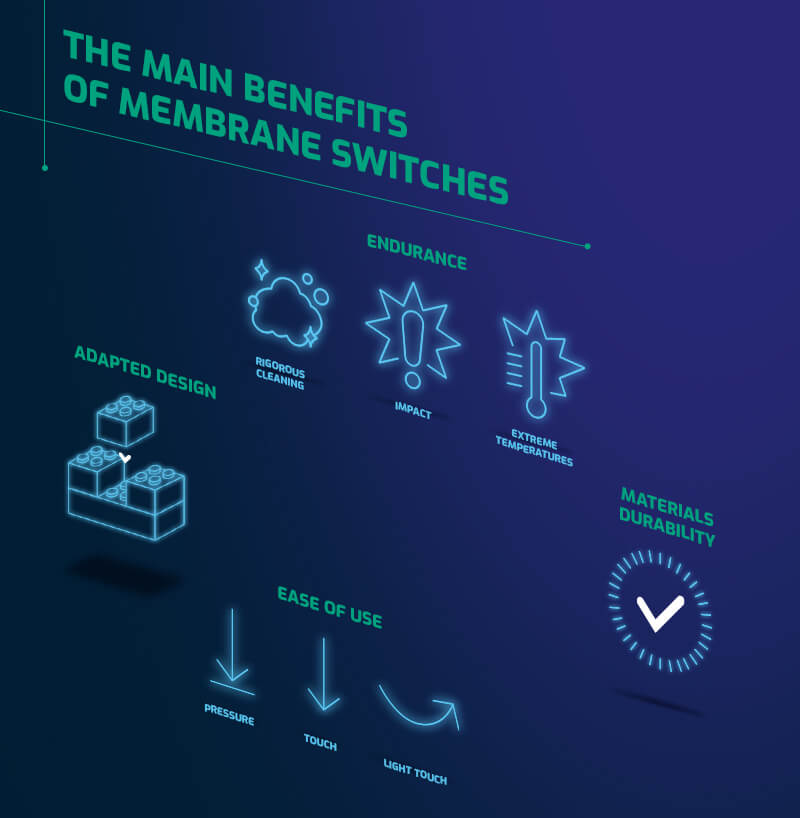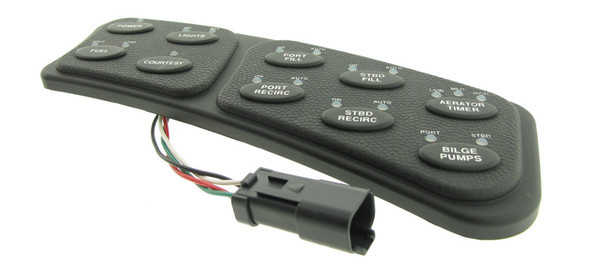Everything About Membrane layer Switch: A Comprehensive Guide for Beginners
Membrane layer buttons are important components in modern-day electronics, providing a distinct interface for individual interaction - membrane switch. Their layered construction, consisting of overlays and conductive traces, provides capability and resilience. Unlike conventional mechanical switches, membrane switches provide a smooth style and personalized choices. Understanding their vital functions and advantages can transform product layout. The details of their application and design factors to consider call for more exploration.
What Is a Membrane layer Switch?
A membrane layer button is a type of electrical switch that contains a flexible membrane layered over a published circuit card. This design permits for a portable and smooth interface, often used in various electronic tools. Membrane switches are commonly discovered in customer appliances, medical devices, and commercial machinery due to their toughness and resistance to environmental factors.The building generally includes numerous layers, such as graphic overlays and adhesive backing, which give responsive responses and shield the wiring underneath. The procedure of a membrane button is initiated when stress is used to the surface area, completing an electrical circuit.These switches are valued for their convenience, allowing customized designs and published graphics that deal with specific interface. Their low-profile nature lowers space requirements, making them optimal for applications where conventional switches may not fit. In general, membrane layer switches use a useful and visual remedy for modern-day electronic gadgets.
Key Components of Membrane Switches
Membrane layer changes make up several key components that add to their performance and efficiency. The leading layer, understood as the overlay, provides the customer interface and is often published with icons or graphics. Underneath the overlay lies a spacer layer, which separates the conductive elements and prevents unintentional activation. The following important component is the graphic layer, which boosts appearances and ensures the sturdiness of the design.Conductive traces, typically made from materials like silver or carbon, are published on the circuit layer. When pressure is used to the overlay, these traces come into get in touch with, completing the circuit. In addition, a backing layer supplies architectural assistance and can be made from materials such as polyester or polycarbonate. With each other, these components produce a trustworthy, easy to use user interface appropriate for numerous applications, from home home appliances to industrial devices. Understanding these aspects is important for anybody curious about membrane button modern technology.
Exactly How Membrane Changes Job
Understanding exactly how membrane layer changes feature is essential for valuing their widespread usage in numerous devices. A membrane layer button operates via a series of layers, including a graphic overlay, spacer, and a circuit layer. When stress is related to the overlay, it presses the spacer layer, permitting the circuit layer to make contact and complete an electrical circuit. This activity sends a signal to the gadget, motivating a response, such as turning on a light or activating a function.Membrane changes can be created with numerous functions, consisting of responsive responses, backlighting, and custom-made graphics, enhancing individual communication. Their construction enables a sealed layout, safeguarding the interior parts from dust, wetness, and impurities. This toughness makes them appropriate for varied applications, from consumer electronics to commercial equipment. Generally, the simpleness and efficiency of membrane switches over add to their popularity in modern-day innovation.
Benefits of Membrane Layer Switches Mechanical Switches
While mechanical buttons have long been a staple in lots of gadgets, membrane switches deal distinctive benefits that make them progressively appealing. One significant advantage is their slim account, permitting even more portable layouts and higher versatility in item advancement. Additionally, membrane switches attribute a consistent surface area, which boosts visual charm and simplifies cleansing, making them ideal for environments where health is critical.Another advantage is their resistance to dust and dampness. Unlike mechanical buttons, which can be endangered by environmental elements, membrane layer buttons supply a closed interface that protects versus contaminants - membrane switch. Membrane layer buttons normally have a longer life-span due to fewer relocating parts, resulting in enhanced durability and reliability.Cost-effectiveness is also a noteworthy advantage, as membrane layer switches can be created in mass with lower production expenses. These variables integrate to place membrane buttons as a functional alternative to standard mechanical options in various applications
Usual Applications of Membrane Switches
Membrane layer switches are widely utilized in numerous sectors, especially in customer electronics and commercial control board. In consumer devices, they give a smooth, easy to use user interface, while in industrial settings, they improve sturdiness and capability. Understanding these applications highlights the flexibility and functionality of membrane switches in contemporary innovation.
Customer Electronics Tools
As consumer electronics continue to develop, membrane switches have actually ended up being a preferred selection for a selection of devices due to their adaptability and smooth layout. These switches are generally located in smart devices, tablet computers, and remote controls, where area is minimal and visual appeals matter. Their low profile and personalized layouts permit suppliers to develop straightforward interfaces that boost the general individual experience. Furthermore, membrane switches are often used in devices such as microwaves and coffee machine, supplying instinctive control choices while withstanding moisture and dust. The durability and reliability of membrane layer changes make them suitable for day-to-day customer items, guaranteeing longevity and regular performance. In general, their integration in customer electronics reflects a blend of functionality and modern-day style.
Industrial Control Panels
The applications of membrane switches over extend past customer electronics, locating significant use in industrial control board. These switches are preferred for their toughness and resistance to rough settings, making them excellent for manufacturing and procedure control setups. They supply a reputable interface for drivers to control equipment, display processes, and readjust settings. Membrane buttons can be personalized to match particular functional needs, incorporating attributes like backlighting and tactile comments, boosting individual experience. Their low-profile layout permits assimilation into numerous equipment, while their ability to withstand spills, dust, and extreme temperature levels guarantees durability. Overall, membrane layer buttons add to secure and effective procedure in industrial applications, demonstrating their adaptability and efficiency popular atmospheres.
Factors To Consider for Creating Membrane Switches
When creating membrane layer buttons, selecting the best products is important to assure resilience and performance. In addition, comprehending layer arrangement techniques can greatly impact the switch's performance and individual experience. These considerations play a crucial duty in developing reliable and effective membrane switch layouts.
Product Option Relevance
Product selection plays an essential role in the design and functionality of membrane layer buttons. The picked products straight impact the switch's sturdiness, tactile action, and total visual. check my source Key considerations include the substratum, which have to supply architectural honesty while enabling versatility, and the graphic overlay, which needs to be resistant to wear and ecological variables. Conductive materials ought to ensure reputable electrical performance, while adhesives have to offer solid bonding without jeopardizing the button's procedure. Furthermore, compatibility with producing processes and end-user environments is vital; products should hold up against differing temperatures, moisture levels, and chemical exposure. Inevitably, suitable material choice not only improves the membrane layer button's performance however likewise contributes to its long life and individual complete satisfaction, making it a critical facet of the style procedure.

Layer Setup Methods

Regularly Asked Concerns
The Length Of Time Do Membrane Layer Changes Typically Last?
Membrane buttons typically have a life-span of 1 to 5 million cycles, depending on use and ecological conditions. Variables such as design high quality and operating regularity significantly influence their resilience and general efficiency longevity.

Can Membrane Layer Switches Over Be Custom-made for Certain Styles?
Membrane switches can without a doubt be tailored to fit particular designs, enabling diverse forms, colors, and functionalities. This versatility makes it possible for producers to customize these buttons to satisfy distinct aesthetic and functional needs successfully.
What Materials Are Used in Membrane Layer Switch Construction?
Membrane layer switches are commonly constructed making use of materials such as polyester, polycarbonate, and glue layers. These materials give resistance, adaptability, and resilience to ecological variables, guaranteeing the switches work properly in various applications and conditions.
Are Membrane Layer Changes Water-proof or Resistant to Wetness?
Membrane layer switches can be developed to be moisture-resistant, making use of specialized coverings and products. Their water-proof capabilities depend on building and construction top quality and details applications, making it essential to assess demands for optimal efficiency in numerous settings.
How Are Membrane Switches Over Repaired if Harmed?
Fixing damaged membrane layer changes usually includes replacing the affected layer or circuit. Professionals may additionally use conductive adhesive or use specialized repair packages, guaranteeing performance is brought back without complete substitute of the whole switch assembly. Unlike standard mechanical switches, membrane layer buttons provide a sleek design and customizable alternatives. A membrane layer switch is a kind of electric switch that consists of a versatile membrane layered over a printed circuit board. The procedure of a membrane button is launched when pressure is used to the surface area, completing an electric circuit.These buttons are valued for their adaptability, enabling custom layouts and printed graphics that provide to details customer interfaces. While mechanical switches have actually long been a staple in lots of devices, membrane layer changes offer distinctive advantages that make them increasingly appealing. Membrane layer switches commonly have a longer life-span due to fewer relocating parts, resulting in boosted sturdiness and reliability.Cost-effectiveness is likewise a notable advantage, site link as membrane layer buttons can be produced in mass with lower production expenses.